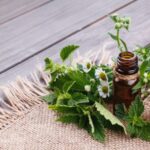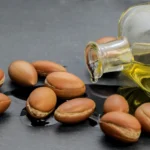På tværs af Afrikas landskaber står der to ikoniske træer med dyb kulturel og økologisk betydning: baobab (Adansonia digitata)der blev æret som "livets træ", og marula (Cercaria birrea, ofte subsp. caffra i det sydlige Afrika)Træet er kendt for sin nærende frugt og olie. I århundreder har samfund i hele Afrika brugt disse træer til mad, medicin, ritualer og hudpleje. Og i dag, baobabolie og marulaolie hyldes globalt som naturlige skønhedsingredienser.
Denne artikel handler om deres historie, hudfordele, indkøbsetik, sikkerhedstips og endda en simpel DIY-opskrift, som man kan prøve derhjemme.
Baobab-olie: Livets træ i hudpleje
Baobabtræer, som kan leve i over tusind år, er økologiske og kulturelle hjørnesten i Sahel og det sydlige Afrika. Landsbyboere samles traditionelt under deres brede baldakiner til markeder og møder, mens næsten alle dele af træet - blade, bark, frugtkød og frø - er blevet brugt til overlevelse.
Næringsstoffer og fordele
Koldpresset baobabfrøolie er let, gylden og hurtigt absorberende. Den er særligt rig på oliesyre (omega-9) og linolsyre (omega-6) fedtsyrersom kan hjælpe med at støtte reparation af hudbarrieren og hydrering. Den indeholder også vitamin A, D, E og F sammen med antioxidanter, der kan hjælpe med at reducere oxidativt stress.
På grund af den afbalancerede fedtsyreprofil trænger baobabolien hurtigt ind uden at efterlade tunge rester, hvilket gør den populær til både tør og kombineret hud. I håret kan den bruges som en let behandling før vask for at blødgøre hårstråene og berolige tør hovedbund. Note om evidens: De fleste data om baobabolies hudplejeeffekter kommer fra undersøgelser på ingrediensniveau og rapporter om traditionel brug; kliniske forsøg er fortsat begrænsede.
Kulturel rolle
Ud over skønhed har baobabmasse længe været spist som en syrlig, C-vitaminrig fødevare i Vestafrika. Olier og ekstrakter fra træet sælges på lokale markeder, hvor kvinder ofte leder små kooperativer, der forarbejder frøene til olie til hjemmebrug og eksport.
Marula-olie: Det sydlige Afrikas skønhedshemmelighed
Marulatræet er dybt forankret i det sydlige Afrikas liv. Dets søde frugt spises frisk eller brygges til traditionelle drikke, og det indgår i ceremonier, der fejrer frugtbarhed og overflod.
Næringsstoffer og fordele
Koldpresset marulaolie af høj kvalitet er værdsat for sin Indhold af oliesyre (hvilket gør den dybt fugtgivende) og dens tocopheroler (E-vitamin) og polyfenolersom giver antioxidantbeskyttelse. I modsætning til tungere olier absorberes marula hurtigt og efterlader huden blød og glat uden at fedte. Dens oxidativ stabilitet Den skiller sig også ud - den modstår harskning hurtigere end mange andre planteolier, hvilket er grunden til, at kosmetikformulatorer værdsætter den til serum og cremer. Evidensnote: Den meste forskning kommer fra sammensætningsanalyse og traditionel brug; kliniske data på mennesker om aktuelle fordele er fortsat begrænsede.
Kulturel rolle
Marula-høsten er stadig en fællesskabsbegivenhed, hvor kvinder samler nedfaldne frugter for at forarbejde dem til kerner og olie. I Namibia og Sydafrika fejrer marulafestivaler træets rigdom og fremhæver dets dobbelte rolle i både ernæring og hudpleje.
Bæredygtighed og etisk høst
Både baobab- og marulaolie illustrerer, hvordan naturlig skønhed er forbundet med fællesskab og økologi.
- Forsyningskæder: Mange olier produceres af kvindekooperativer, der støtter levebrødet i landdistrikterne.
- Certificeringer at kigge efter: Fair Trade, økologisk eller tredjeparts bæredygtighedsrevisioner.
- Advarsel om grønvaskning: Markedsføringsudtryk som "vildt høstet" kan være vage. Se efter sporbare forsyningshistorier, analysecertifikater (COA'er) og dokumentation for fair samfundsfordele.
- Økologisk rolle: Begge træer er afgørende for biodiversiteten; bæredygtig høst sikrer, at frøene indsamles uden at skade økosystemerne. Bevidste forbrugervalg hjælper med at beskytte disse gamle træer og opretholde de samfund, der er afhængige af dem.
Praktisk brug og sikkerhed
- Brug i ansigtet: Start med 2-3 dråber på fugtig hud.
- Hårpleje: Brug sparsomt som leave-in for at kontrollere krus, eller påfør generøst som en 15-30 minutters hovedbunds- og hårmaske før vask.
- Blanding: Kombiner baobab (let) og marula (mere silkeagtig) til et afbalanceret dag-til-nat-serum.
- Æteriske olier: Hvis du tilsætter, skal du holde dig under 0,5% til ansigtsblandinger. Undgå stærke æteriske olier under graviditet, eller hvis du har følsom hud.
Opbevaring og holdbarhed
Uraffinerede olier holder generelt 6-18 måneder afhængigt af forarbejdning, emballering og opbevaring. Tjek altid "bedst før"-datoer, opbevar i mørke glas, og kassér olien, hvis den lugter harsk eller ændrer farve.
Allergi og følsomhed
Begge olier er generelt veltolererede, men naturlige olier kan stadig forårsage reaktioner. Lav altid en lappetest i 24-48 timer på indersiden af underarmen. Marulaolie kommer fra en træ-nøddekerne, så forsigtighed tilrådes for dem med nøddeallergi.
Regulatorisk note:
Disse olier er kosmetiske ingredienser. Anprisninger som "behandler eksem" eller "kurerer akne" kræver godkendelse fra myndighederne; sikrere formuleringer er "kan hjælpe med at understøtte hydrering" eller "hjælper med at blødgøre huden".
DIY Serum til udstråling: Baobab og marula
Ingredienser
- 1 spsk baobab-olie
- 1 spsk marulaolie
- 2 dråber æterisk lavendelolie (valgfrit, ≤0,5%)
Metode
- Bland olierne i en dråbeflaske af mørkt glas.
- Ryst forsigtigt.
- Påfør 2-3 dråber på ren, fugtig hud om aftenen.
Sikkerhedsbemærkninger
- Lav en lappetest før første brug.
- Undgå æteriske olier, hvis du er gravid eller følsom.
- Opbevares køligt og mørkt; tilsæt 1-2 dråber E-vitaminolie for at forlænge friskheden.
Afsluttende tanker
Baobab- og marulaolier er mere end hudplejeingredienser - de er en levende arv fra Afrikas økologiske og kulturelle arv. Fra baobabmarkeder i Vestafrika til marulafestivaler i det sydlige Afrika bærer disse olier århundreders traditioner ind i nutidens skønhedsrutiner. Ved at vælge koldpressede olier fra bæredygtige kilder Med støtte fra gennemsigtige kooperativer og certificering plejer forbrugerne ikke kun deres hud, men støtter også biodiversitet og levevilkår i landdistrikterne.
Hver dråbe er mere end hydrering - det er en bro mellem ældgammel praksis og moderne velvære, der minder os om, at skønhed er stærkest, når den er forankret i fællesskab og bæredygtighed.
Relaterede indlæg
-
Afrikanske skønhedsolier: Marula & Baobab - hudplejehemmeligheder fra kontinentet
I generationer har lokalsamfund i hele Afrika brugt indfødte træer, ikke kun til mad og...
-
Fingerhirsepandekager med baobab-sirup
Fra serien: Reviving Forgotten Staples - Modern Ways to Enjoy Kenya's Indigenous Grains A...
-
Afrikanske skønhedsolier: Forfædrenes visdom møder moderne hudpleje
På tværs af Afrikas forskellige landskaber fra den solbeskinnede Kalahari til de frodige savanner i Vestafrika...


